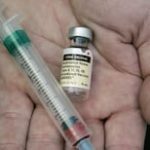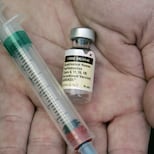



New research released in recent days indicates that 60% of patients with ALK-positive advanced lung cancer continue their lives without disease progression after five years.

Health
Health. What is lung cancer: main symptoms and treatments
The study, carried out by Pfizer, was presented at the annual meeting of the American Society of Clinical Oncology 2024. It was a long-term follow-up of the phase 3 CROWN trial, which evaluates a third-generation ALK inhibitor, available in Argentina , compared with a first-generation ALK inhibitor in people with previously untreated ALK-positive advanced non-small cell lung cancer (NSCLC).
After five years of median follow-up, the study showed an 81% reduction in the rate of disease progression or death among patients treated with the third-generation ALK inhibitor, compared with a first-generation ALK inhibitor. generation.

Citizens
Drugs. Argentine research reveals a more effective treatment against a bacteria that causes gastric cancer
Additionally, 60% of patients treated with the newer therapy were alive without disease progression after five years compared to 8% with the first-generation drug. These data were announced Friday in an oral presentation at the American Society of Clinical Oncology (ASCO) 2024 Annual Meeting (Abstract LBA8503) and have been simultaneously published in the Journal of Clinical Oncology.
“These results from the CROWN trial are unprecedented, as the majority of patients receiving the third-generation ALK inhibitor are living more than five years without disease progression,” said Roger Dansey, MD, Chief Development Officer, Oncology. , Pfizer. “These results are an excellent example of Pfizer’s long-standing commitment to discovering and developing scientific breakthroughs for patients, and support our therapies as a standard of care for the first-line treatment of people with ALK-positive advanced NSCLC.”

Agencies
New studies suggest that HPV vaccines prevent cancer in men and women
Lung cancer is the deadliest of all
Lung cancer is the leading cause of cancer-related death worldwide. In Argentina, it is the second with the highest mortality, above breast, colorectal, pancreatic and prostate cancer. In turn, it is the fourth in incidence, with around 13 thousand new cases per year, which represents 9.8% of all cancer cases.
Non-Small Cell Lung Cancer (NSCLC) accounts for approximately 80-85% of lung cancers, and tumors with alterations in the ALK protein occur in approximately 3-5% of NSCLC cases. Approximately 25-40% of people with ALK+ advanced NSCLC may develop brain metastases within two years of initial diagnosis. Pfizer has developed a therapy with the objective of specifically inhibiting the mutated ALK protein, including resistance alterations induced by other ALK inhibitors and with greater penetration into the blood-brain barrier.

Citizens
Melanoma. Protecting yourself from the sun reduces the risk of skin cancer by 70%
In this sense, Dr. Diego Kaen (MP 1898), Head of Clinical Oncology and Research at the Riojano Integral Oncology Center (CORI) stated: “We are talking about the era of cancer chronification. 10 years ago, a patient with an advanced stage did not live more than six months, and today more than 50% in those same conditions can survive five years and continue without progression of the disease.”
Likewise, he added: “It is a disease with very high mortality. In fact, it is the one that causes the most deaths worldwide, but fortunately we are beginning to have concrete and reliable data that, in the face of some molecular subtypes of lung cancer, we are already facing a chronic disease.”
“ALK-positive advanced NSCLC is typically aggressive and often affects young people in the prime of their lives,” said Benjamin Solomon, MBBS, Ph.D., Department of Medical Oncology, Peter MacCallum Cancer Center, and Research Fellow. CROWN Essay Principal. “This updated analysis shows that the third-generation ALK inhibitor helped patients live longer without disease progression, and most patients experienced sustained benefit for more than five years, including almost all patients had protection.” against the progression of the disease in the brain. “These improvements in outcomes for patients with ALK-positive NSCLC represent a notable advance in lung cancer.”
Details of the results
In this updated analysis, the third-generation ALK inhibitor showed a 94% reduction in the risk of developing intracranial progression (HR, 0.06; 95% CI, 0.03-0.12). The median time to IC progression (95% CI, NR-NR) was not reached with the third-generation inhibitor and was 16.4 months (12.7-21.9) with the first-generation inhibitor generation. In people without brain metastases at baseline who received the newer therapy, only 4 of 114 developed brain metastases within the first 16 months of treatment, compared with 39 of 109 patients who received the older therapy. At the time of the analysis, 50% of patients in the CROWN trial were still receiving the third-generation inhibitor compared with 5% of patients receiving a comparator treatment.
“Although ALK-positive advanced NSCLC accounts for approximately five percent of all NSCLC cases, this translates to 72,000 people being diagnosed worldwide each year,” said Kenneth Culver, MD, Director of Research and Clinical Affairs. from the non-profit organization ALK Positive. “These new results from the CROWN trial symbolize significant progress in front-line treatment for the targeted treatment of ALK-positive lung cancer, which has led to notable improvements for the patient community.”
The safety profiles of the two drugs involved in the five-year follow-up were consistent with previous findings, with no new safety signals. In this analysis, the most frequent adverse events (AEs) (≥20%) reported in patients treated with third-generation therapy were consistent with the 2020 analysis of the CROWN trial, which included edema, weight gain, peripheral neuropathy, side effects. cognitive effects, mood effects, diarrhea, dyspnea, arthralgia, hypertension, headache, cough, pyrexia, hypercholesterolemia and hypertriglyceridemia. Grade 3/4 AEs occurred in 77% of patients on third-generation therapy and 57% of patients on first-generation therapy. Treatment-related AEs led to permanent treatment discontinuation in 5% and 6% of patients in the third-generation and first-generation therapy arms, respectively.
Early detection
Early diagnosis also contributes to the success of treatment, which is why it is essential to undergo periodic studies to identify the tumor at an early stage. For this reason, Dr. Kaen highlighted that “early detection is essential, especially for patients with risk factors. If someone is a smoker or has a family history of any type of cancer, they should go to their family doctor and get tested. What is called ‘screening’ for lung cancer is performed, so that it can be detected in time and in this way the corresponding treatment can be carried out.”
Pfizer continues its commitment to helping non-scientists understand the latest findings with the development of plain language summaries of abstracts (APLS) for company-sponsored research presented at ASCO, which are written in non-technical language. . Those interested in learning more can visit www.Pfizer.com/apls to access the summaries.
About the CROWN trial
CROWN is a phase 3, randomized, open-label, two-parallel-arm trial in which 296 people with previously untreated ALK-positive advanced NSCLC were randomized 1:1 to receive monotherapy with a third-generation ALK inhibitor (n=149 ) or monotherapy with a first-generation ALK inhibitor (n=147). The primary objective of the CROWN trial is PFS based on Blinded Independent Central Review (BICR). Secondary objectives include PFS as assessed by investigator, overall survival (OS), objective response rate (ORR), intracranial objective response (IOR), and safety. Since the mean PFS was not reached after three years of follow-up, an unplanned post hoc analysis was performed with the intention of further quantifying the long-term outcomes as assessed by the investigator’s tumor in this study at a follow-up. clinically significant five-year period.

